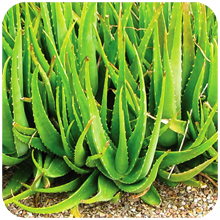
Aloe is one of the most appreciated plants on the planet and has been used in various forms since ancient times. Aloe Barbadensis is also known as Aloe Vera, the Latin word that means “true aloe”, a term that is due to significant therapeutic effect. The plant belongs to the family Liliacee. Aloe has a height of 75-120 cm, having a stem that develops among the leaves and flowers that ends with yellow, orange or red flowers of cylindrical form. Flowering takes place 2-3 years after planting. The 12-15 leaves grow directly from the soil. Leaves are thick, fleshy, juicy, pale green in color, lance-shaped with toothed edges and covered with a waxy coating. Leaf size depends on climatic conditions and soil quality as in favorable conditions, it can grow very quickly. Harvesting of leaves may begin only after maturity, means 3-4 years after planting.
Chemical composition – Contains anthrone, heteroside or aglycone, resins, chromone derivatives, aglycone and C-glycosides (aloe resin A, B C), glycosides of 6 phenylpyran- 2-one (aloenine A and B). Aloe contains 18 of the 22 amino acids needed for body (7 out of the 8 essential amino acids: valine, leucine, isoleucine, phenylalanine, methionine, lysine and threonine). It also contains vitamins (A, B1, B2, B6, B12, C and E) and minerals (iron, calcium, magnesium, copper, chromium, iodine, selenium, manganese, zinc). Other substances in aloe leaf are sterols (cholesterol, sitosterol, campesterol, lupeol), hormones (auxins and gibberellins), lignin and saponins.
Properties – Immunostimulant, antitumor, hypoglycemic, anti-inflammatory, healing, antiulcer, antiviral, antibacterial, laxative, purgative, antidiabetic, dermoprotective, liver tonic, ensures development and recovery of muscle mass.
Recommendation – Abscess, acidity, eye diseases, intestinal, liver and skin disorders, mouth disorders, alcoholism, allergies, angina, anorexia, heartburn, arthritis, bronchial asthma, bronchitis, tumors, cataracts, cramps, dermatitis, colitis, constipation, headache, diabetes, stomach pain, dyspepsia, eczema, edema, fissures, genital herpes, hemorrhoids, hypertension, inflammation, mastoiditis, neurasthenia, obesity, rheumatism, thrombophlebitis, pulmonary tuberculosis, intestinal worms, viral respiratory infections varicose veins.
This plant is incorporated in natural remedies GASCURE Syrup, LIVECOM Syrup, SHECURE Syrup.




